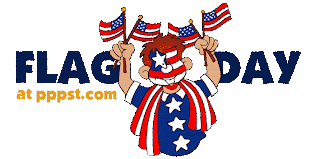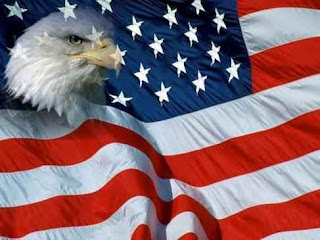UNITED STATES - The United States FLAG DAY 2011 History. The United States Flag Day Celebrated on 14 June. It commemorates the adoption of the flag of the United States, which happened on that day by resolution of the Second Continental Congress in 1777. The U.S. military is the Army Birthday celebration on this day, Congress adopted "American Continental Army" after reaching a consensus position on the committee of the whole to June 14th 1775th
In 1916 President Woodrow Wilson issued a proclamation officially on June 14 as Flag Day was established in August 1949, the National Flag Day by an Act of Congress.
Flag Day is not an official federal holiday, but on June 14, 1937, Pennsylvania, the first (and only) U.S. state to celebrate Flag Day was a holiday, starting in the town of Patterdale race. Title 36, United States Code, Subtitle I, Part A, Chapter 1, § 110 is the official law on Flag Day, but it's the president, at its discretion, officially proclaiming the observance.
One of the longest running Flag Day Parade is held annually in Quincy, Mass., which began in 1952, celebrates its 59th year take place in 2010. The 59th Appleton, Wisconsin Annual Conference 2009 Flag Day Parade featured the U. S. Navy. The largest Flag Day Parade is held annually in Troy, New York, based on their parade and the parade typically draws 50,000 spectators in Quincy location.
Perhaps the oldest Flag Day parade is still in Washington, Fairfield. Beginning in 1909 or 1910, Fairfield has a parade every year since with the possible exception of 1918, and celebrated the "Centennial" parade in 2010, along with several other commemorations.
Several individuals and organizations played important role in establishing a national Flag Day celebration. They are listed here in chronological order. There are:
1861, George Morris
The earliest reference to the proposal of a "Flag Day" is cited in Kansas: an encyclopedia of State History, by Standard Publishing Company in Chicago, published in 1912. It credits George Morris of Hartford, Connecticut:
George Morris of Hartford, Connecticut, in popular parlance is the merit of proposals, as "Flag Day" in honor of the occasion of the adoption of the American flag on June 14 1777th the city of Hartford observed the day in 1861, the implementation a program of a patriotic order, praying for the success of the Federal Republic of weapons and the preservation of the Union.
Compliance apparently become a tradition.
1885, Bernard J. Cigrand
Stony Hill School in Waubeka, Wisconsin, where the first formal observance of Flag Day
Working as an elementary school teacher in Waubeka, Wisconsin, in 1885, Bernard J. Cigrand held the first recognized formal observance of Flag Day at Stony Hill School. The school was renovated, and a bust of Cigrand also honors him at the National Flag Day Americanism Center in Waubeka.
From the late 1880s on, Cigrand spoke around the country promoting patriotism, respect for the flag and the need for the annual celebration of the flag on 14 days in June, the day the Continental Congress in 1777 that the Stars and Stripes adopted.
He moved to Chicago to dental school, and in June 1886 for the first time in public, an annual celebration of the birth of the United States flag in an article titled "The Fourteenth of June", published in the Chicago Argus newspaper suggested . In June 1888 Cigrand the foundation of the holiday in a speech arguing against the "sons of America," a Chicago group. The organization founded a magazine, American Standard, in order to promote reverence for American emblems. Cigrand appointed editor-in-chief and wrote articles in the magazine and in other magazines and newspapers to promote the holiday.
On the third Saturday in June 1894 a public school for the children was held on the occasion of Flag Day in Chicago at Douglas, Garfield, Humboldt, Lincoln and Washington parks. More than 300,000 kids, and the celebration was repeated the following year.
Cigrand president of the American Flag Day Association and later became the National Flag Day Society, which enabled him to support his cause with organizational promotion. Cigrand was recalled in 2188 that he had speeches about patriotism and the flag data.
Cigrand lived in Batavia, Illinois, 1913-1932.
Cigrand generally credited with being the "Father of Flag Day," the Chicago Tribune noted that he "almost single-handedly," were on vacation.
1888, William T. Kerr
William T. Kerr, a resident of Collier Township, Pennsylvania for several years, the American Flag Day Association of Western Pennsylvania, founded in 1888, and this association was the national chairman one year later, as such for 50 years. He attended President Harry S. Truman's signing of the 1949 Act of Congress who profess to be formally established the observance.
1889, George Bolch
In 1889, the fourth principle of free kindergarten, George Bolch, celebrated Flag Day and the Revolution, as well.
1893, Elizabeth Duane Gillespie
In 1893, Elizabeth Duane Gillespie attempted, a descendant of Benjamin Franklin and the chairman of the Colonial Dames of Pennsylvania, adopted a resolution that the American flag on all public buildings in Philadelphia is shown. This is why some credit as the Philadelphia Flag Day original home. In 1937 the first state of Pennsylvania to-day legal holiday flag.
1907, BPOE
American fraternal order and social organization of the benevolent and protective Order of Elks, the holiday celebrated since the early days of the organization and loyalty to the flag is a requirement of every member. In 1907, the BPOE Grand Lodge, by order of June 14 Designated as Flag Day. The Grand Lodge of the Order adopted mandatory observance of the occasion by every Lodge in 1911, and this requirement further.
The Elks prompted President Woodrow Wilson to the order, the observance of Flag Day for its patriotic expression recognition.
1908, Theodore Roosevelt
Oral tradition has been passed down through several generations, on June 14, Theodore Roosevelt had dinner outside of Philadelphia, as he wiped his nose with a man he thought had noticed the American flag. In anger, Roosevelt took a small wooden stick and began to whip the man "maim the symbol of America." After about five or six strong strokes, he noticed that the man is not his nose with a flag, but with a blue scarf with white stars. After realizing this, he apologized to the man, but hit him again for his "angry with national pride."
1913, City of Paterson, New Jersey
During the 1913 Paterson silk strike, IWW leader "Big" Bill Haywood, said that one day the whole world would be red flags, "the color of the blood of the working man." Then said the leaders of the city (as opposed to the strike), March 17 to
"Flag Day", and made sure that each garment factories of the city, an American flag flew. This attempt by Paterson leaders, the strikers went un-American than wrong when the strikers marched through the city with American flags on their own, along with a banner that said to represent:
" WE WEAVE THE FLAG
WE LIVE UNDER THE FLAG
WE DIE UNDER THE FLAG
BUT DAM'D IF WE'LL STARVE UNDER THE FLAG. "
Observance of Flag Day 2011
The week of June 14 is designated as "National Flag Week". During National Flag Week, the chairman gave a proclamation to urge U.S. citizens to the American flag for the duration of that week. The flag should be displayed on all government buildings. Some hold parades and events to the national flag of America and everything it represents to celebrate. Other organizations and tribes to resist the protests and celebrations.
National Flag Day Foundation holds an annual eight for the Flag Day on the second Sunday in June. The program includes a formal investigation of the flag, the recitation of the Pledge of Allegiance, singing the national anthem, a parade and much more.
The Betsy Ross House has long been the site of Philadelphia is the observance of Flag Day was.







0 komentar:
Post a Comment